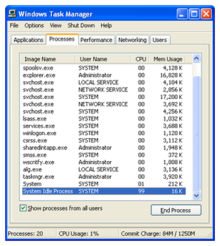This is an old revision of this page, as edited by 67.90.197.194 (talk) at 19:48, 22 August 2007 (Removed vandalism at the bottom and consolidated repetition). The present address (URL) is a permanent link to this revision, which may differ significantly from the current revision.
Revision as of 19:48, 22 August 2007 by 67.90.197.194 (talk) (Removed vandalism at the bottom and consolidated repetition)(diff) ← Previous revision | Latest revision (diff) | Newer revision → (diff)| This article may require cleanup to meet Misplaced Pages's quality standards. No cleanup reason has been specified. Please help improve this article if you can. (June 2007) (Learn how and when to remove this message) |

In Windows NT-based operating systems, the System Idle Process is the system idle task: it tracks how much of the CPU's time is being utilized and issues the HLT instruction to cut the processor's power usage. In the Windows Task Manager, it provides information about how heavily loaded the CPU is. In a system that is not very busy, such as a typical workstation waiting for input, the idle process accounts for over 90% of the CPU.
There are 32 levels of priority: 1 through 15 for the common applications, 16 through 31 for critical threads, and a priority 0 that is used only for the system idle process. The higher the number, the greater the priority. Priorities 1 through 15 are the dynamic priorities that typical applications get assigned. The priorities of threads in this realm are constantly being changed, getting bumped and degraded according to need by the Operating System (OS).
Priorities 16 through 31 are not dynamic, this is what is meant by "real time" when talking about a threads priority. The priority of real time threads is constant as the OS does not change them. These priorities are used for operations that are time critical. In addition, users with administrative authority can also set real time priorities for applications on their own.